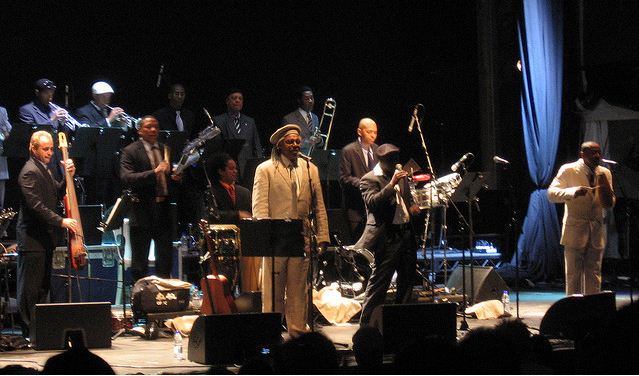Buena Vista is “hasta la vista”. Juan de Marcos Gonzalez, the founder of the famous group whose album “Buena Vista Social Club” won a Grammy in 1998, has evolved the group into a smaller and more versatile ensemble.
This evolution of the Afro-Cuban All-Stars was forced in part by the passing of some of its elderly founding members. Most passed during the first decade of the 2000s. The departed include such Cuban music glories as Ibrahim Ferrer, Manuel “Puntillita” Licea, Compay Segundo, Ruben Gonzalez, Pio Leyva, and Orlando “Cachaito” Lopez.
But instead of sticking with the winning formula, Juan de Marcos decided to evolve the sound of the band. He expanded its repertoire to include jazz.
“I want to show people that we can maintain the traditional Cuban music essence and play a wide range of musical rhythms, from traditional Cuban melodies to Latin jazz”, explained Juan de Marcos in an exclusive interview with Latino Music Café.
The Origins of Buena Vista Social Club
Juan de Marcos was born in the Pueblo Nuevo neighborhood of Havana. This was also the birthplace of many of Cuban popular musicians, including legendary percussionist Chano Pozo. His dad, Marcos Gonzalez, was a popular singer who spent a few years with Cuban music great Arsenio Rodriguez.
Through his dad, Juan de Marcos knew many of the musicians of his dad’s generation. This included pianist Ruben Gonzalez who was also part of the Arsenio Rodriguez “conjunto”.
“As a young musician, I didn’t take the traditional Cuban music. Instead, I started my career as a rocker. Rock was prohibited in Cuba in those days as the governments classified it as “imperialist” music. As young guys, we wanted to play the prohibited rock”, explains Juan de Marcos.
“It was Carlos Santana who influenced me to look at the music of my country again,” says the also founder of traditional Cuban “son” music group Sierra Maestra. “We listened to rock through AM radio stations from the US, and when I heard Santana playing cha-cha-cha (‘Black Magic Woman’ and ‘Oye Como Va’), it made me look back at the music I grew up with at home and at my neighborhood.”
This seed led to the forming in 1976 of the band Sierra Maestra, who played traditional son with the same instrumental lineup as the groups of the 1920s and 30s, but dressed like “punks”. Sierra Maestra was well received by the Cuban public. Then in 1995, they released “Dundunbanza”, an album tribute to Arsenio Rodriguez.
Juan de Marcos added, “in this album we beefed up the band for some songs, trying to resemble the three trumpets, conga, and piano lineup that the Arsenio Rodriguez ‘conjunto’ had”.
The Two Albums that Marked Cuban Music
“Dundunbanza” was a commercial success, and opened doors to two concept albums Juan de Marcos wanted to do:
- A “Big Band” album (of the 50’s big band style) in tribute to his dad Marcos Gonzalez and the musicians of his generation.
- A traditional Son Oriental album (“Eastern album”), with the same lineup but without the big band winds.
For the 1st album, Juan de Marcos wanted to include some elderly musician friends of his dad.
He got Ruben Gonzalez, Chachaito Lopez, Luis Alemany, Guajiro Mirabal, Pio Leyva, Raul Plana, Puntillita, and others. Omara Portuondo was added by coincidence. They met at the recording studio as she was leaving after recording another album. Juan de Marcos immediately took the opportunity to invite her to participate in a song with Ibrahim Ferrer.
“Ibrahim was the only one I didn’t know of the elderly, but we liked how he sang, so I approached him to participate in the projects” says Gonzalez.
This big band album would later be titled “A Toda Cuba Le Gusta”, and the band took the name of the Afro-Cuban All-Stars.
Beside the elderly legends recruited by Juan de Marcos, the groups also included many young musicians. They provided a contemporary sound to balance the traditional music played by the elders. Juan de Marcos would provide the contemporary arrangements to these traditional songs played with a big band.
For the “Eastern album” Juan de Marcos was going to use basically the same lineup of musicians. However, he wanted to remove most of the winds leaving just one trumpet, as they are not needed to play “son oriental”. He also wanted to make the album to lean toward “world music”. For this, he invited some African musicians from Mali and included Ry Cooder to help bring it all together musically. The African musicians couldn’t get their visas, so the album was recorded as a straight-up “son oriental” album.
They decided to name the album after one of the songs, “Buena Vista Social Club”.
The Success of Both Albums
The album became hugely popular through word-of-mouth and thanks to a film of the making of the album.
The film, which featured interviews with the Cuban music legends participating in the recording, became hugely popular around the world.
The album won a Grammy award in 1998. The big band album, “A Toda Cuba Le Gusta” was also nominated for a Grammy.
Afro-Cuban All-Stars New Projects and Seattle Visit: Coming in Part 2:
In the 2nd part of our conversation with Juan de Marcos, we’ll touch on the new projects coming for the Afro-Cuban All-Stars. This includes the U.S. tour and their stop in Seattle’s Jazz Alley.

